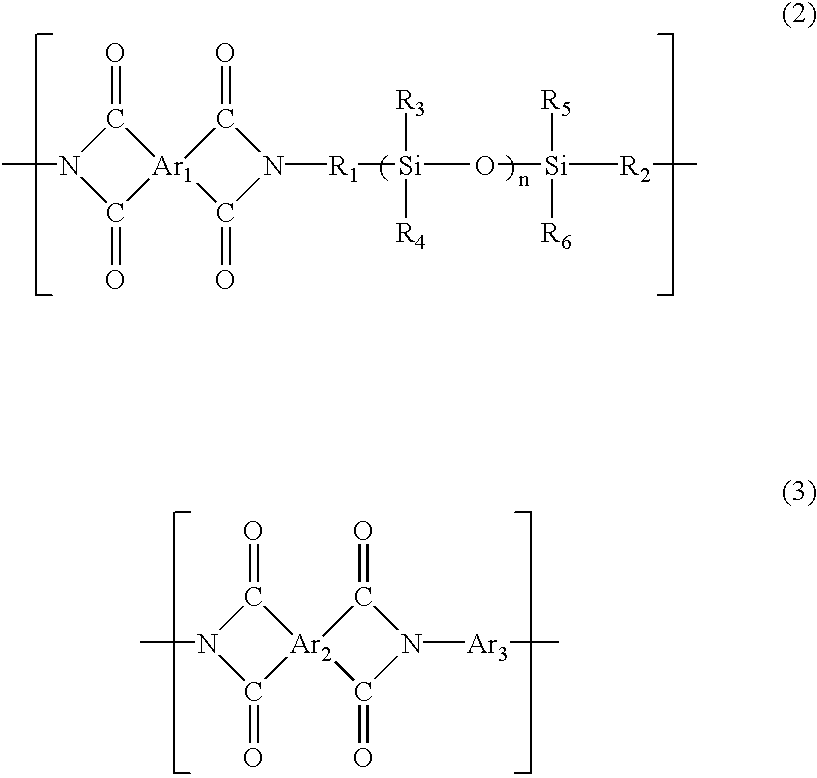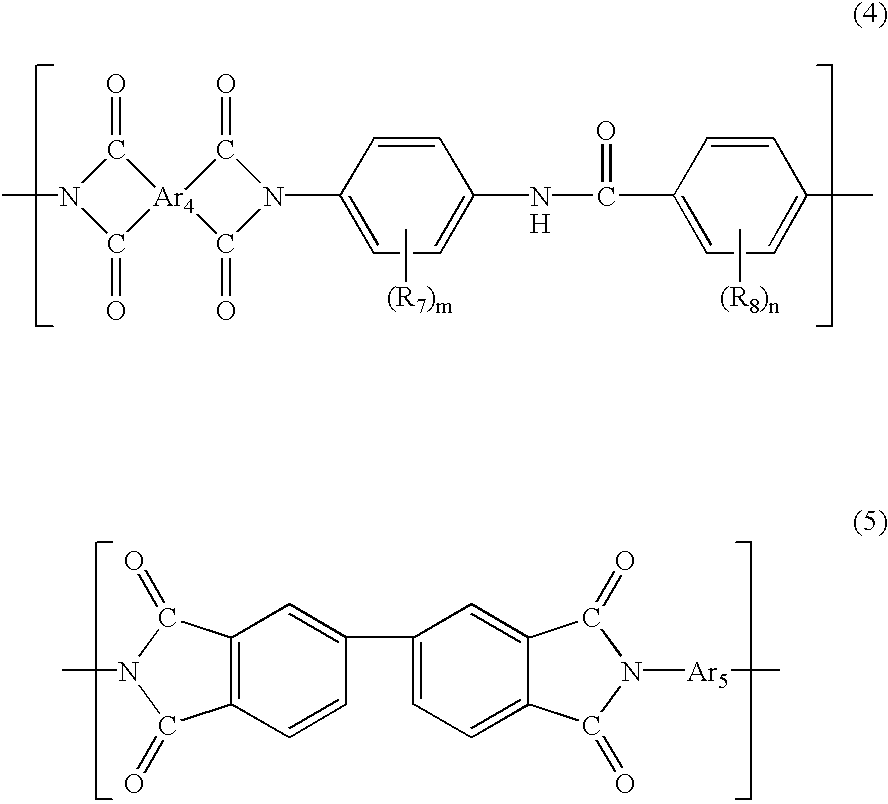Adhesive polyimide resin and adhesive laminate
a technology of adhesive laminate and polyimide resin, which is applied in the direction of synthetic resin layered products, packaging, wood working apparatus, etc., can solve the problems of reducing the heat resistance of the resin, affecting the freedom of operation process, and substantial thermal damage to the materials around, so as to improve the heat resistance and reduce the adhesiveness. , the effect of high degree of freedom
- Summary
- Abstract
- Description
- Claims
- Application Information
AI Technical Summary
Benefits of technology
Problems solved by technology
Method used
Image
Examples
synthesis example 1
[0090]In a Dean-Stark type reactor equipped with a stirrer and a nitrogen introducing pipe were charged 69.65 g (0.225 mole) of ODPA and 150 g of triglyme, to which 90.00 g (0.1175 mole) of PSX was added by using a dropping funnel under a nitrogen atmosphere, and the mixture was stirred at room temperature for about 2 hours. Subsequently, the reaction mixture was heated at 190° C. under the nitrogen atmosphere, followed by heating and stirring for 15 hours while removing condensation water. Then, the reaction mixture was cooled to room temperature and 36.54 g (0.089 mole) of BAPP, 3.92 g (0.018 mole) of HAB, and 150 g of triglyme were added thereto. The obtained reaction mixture was heated at 70° C. under the nitrogen atmosphere and stirred for about 2 hours to obtain a siloxane polyimide precursor resin solution having a solid content of 40% by weight.
synthesis example 2
[0091]In a reactor were charged 48.58 g (0.1566 mole) of ODPA and 130 g of triglyme, to which 60.00 g (0.0783 mole) of PSX was added by using a dropping funnel under the nitrogen atmosphere and the mixture was stirred at room temperature for about 2 hours. Subsequently, the reaction solution was heated at 190° C. under the nitrogen atmosphere, followed by heating and stirring for 15 hours while removing water. Then, the reaction mixture was cooled to room temperature and 60.06 g (0.1463 mole) of BAPP, 4.22 g (0.0195 mole) of HAB, 27.14 g (0.0875 mole) of ODPA, and 150 g of triglyme were added thereto, and the obtained reaction mixture was heated at 70° C. under the nitrogen atmosphere and stirred for about 2 hours. Further, addition of triglyme so that the solid content was 40% by weight to obtain a siloxane polyimide precursor resin solution.
synthesis example 3
[0092]In a reactor were charged 65.61 (0.223 mole) of BPDA and 130 g of triglyme, to which 99.96 g (0.1305 mole) of PSX was added by using a dropping funnel under the nitrogen atmosphere, and the mixture was stirred at room temperature for about 2 hours. Subsequently, the reaction mixture was heated at 190° C. under the nitrogen atmosphere, followed by heating and stirring for 15 hours while removing condensation water. Then, the reaction mixture was cooled to room temperature and 30.54 g (0.0744 mole) of BAPP, 3.85 g (0.0178 mole) of HAB, and 150 g of triglyme were added thereto. The obtained reaction mixture was heated at 70° C. under the nitrogen atmosphere and stirred for about 2 hours. Further, triglyme was added so that the solid content was 40% by weight to obtain a siloxane polyimide precursor resin solution.
PUM
| Property | Measurement | Unit |
|---|---|---|
| storage modulus | aaaaa | aaaaa |
| glass transition temperature | aaaaa | aaaaa |
| glass transition temperature | aaaaa | aaaaa |
Abstract
Description
Claims
Application Information
 Login to View More
Login to View More - R&D
- Intellectual Property
- Life Sciences
- Materials
- Tech Scout
- Unparalleled Data Quality
- Higher Quality Content
- 60% Fewer Hallucinations
Browse by: Latest US Patents, China's latest patents, Technical Efficacy Thesaurus, Application Domain, Technology Topic, Popular Technical Reports.
© 2025 PatSnap. All rights reserved.Legal|Privacy policy|Modern Slavery Act Transparency Statement|Sitemap|About US| Contact US: help@patsnap.com



